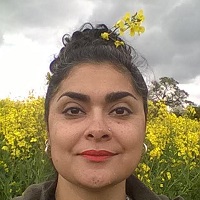I think all of us are in search of better ways to live our lives.
Whether we live according to Vedic, Sufi, or Buddhist wisdom, desire fulfillment (be it spiritual or earthly), or simply seek that elusive “happiness,” all of these paths lead to the same destination—transformation.
Transformation of Self. Transformation of You. Inner You. Essence You. Prana You. Non-Mind You. Real You.
Yet I’ve found it’s really easy to get swept up in all the different stuff out there and, in the process, lose sight of this necessary but basic understanding:
All transformation begins and ends with you.
Our inner teacher comes to life when we choose to open ourselves up to spiritual teachings and our own innate wisdom. But what often occurs, as did with me, is that we begin to direct our attention outward. It’s a natural inclination; as we learn new and amazing concepts about curbing our minds and being in our bodies, observing others seems an obvious way for us to study and learn more.
We identify things we learn about in other people: “Oh, he’s not being present” or “You’re so scattered. Maybe you should practice some mindfulness.” Caught up in our own sense of self-righteousness, we often direct these things at our partners (it’s not a good idea, and very rarely works out well—trust me).
The real trick is identifying these things in ourselves. This is difficult for us for one reason only: It requires work on consciousness, a concept that scientists have ignored in the field of neuroscience for decades that is now receiving much attention.
We need to consciously become conscious beings through observing our own actions, thoughts, and words.
This is by no means an easy feat, which is exactly why there are so many practices out there to help us. Martial arts can facilitate this transformation. Yoga asana can facilitate it. Mindfulness of breath and body can facilitate it. Sufi breath practices can facilitate it. Qigong. You get the idea.
However, if we lose touch of the reason we are doing these practices, or force our intellectual brain to understand, we will find ourselves reaching a wall, again and again.
When I was doing a yoga teacher training course with a lovely, down-to-earth teacher named Dave Charlton, who introduced me to the beautiful flow that is Viniyoga, I recall having my mind blown regularly. (I have heaps of gratitude for him.)
One concept that he unpacked has particularly stayed with me in my own teaching and also as a perpetual student—Purusha. The way I understand it after many, many years of contemplating this concept, is that Purusha is the light behind the eyes. Forget all the big words and lengthy explanations. If we stay with the simplicity of this image, and attempt to grasp it only with intuition, it feels clearer. Light.
We can actually see this light. If you look into people’s eyes—your own eyes even—there’s always a weird kind of feeling. Like you’re looking at something you can’t quite put your finger on…
I found myself drawn to the idea of dwelling in Purusha. I still am. Keep in mind; these are not things we are meant to understand with our left brain, right brain system. None of these things are intellectual. They come from that silent place, the place of no words—our intuition.
We can all stay in touch with this place within us, absolutely. But trying to use mind, will probably not get us anywhere. For this is the place where the mind ends and You begin…
So if you find yourself a little lost, go back to You—not Personality You, but Silent You. Refrain from looking at others. Judging others. Criticizing others.
We can all work on getting in touch with the Self that dwells in the stillness and silence, because ultimately, that is the key to all practices and paths of transformation.
~
~
Author: Sascha Akhtar
Image: William Stitt/Unsplash
Editor: Callie Rushton


 Share on bsky
Share on bsky





Read 0 comments and reply